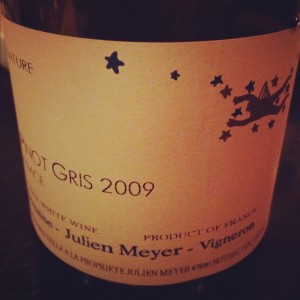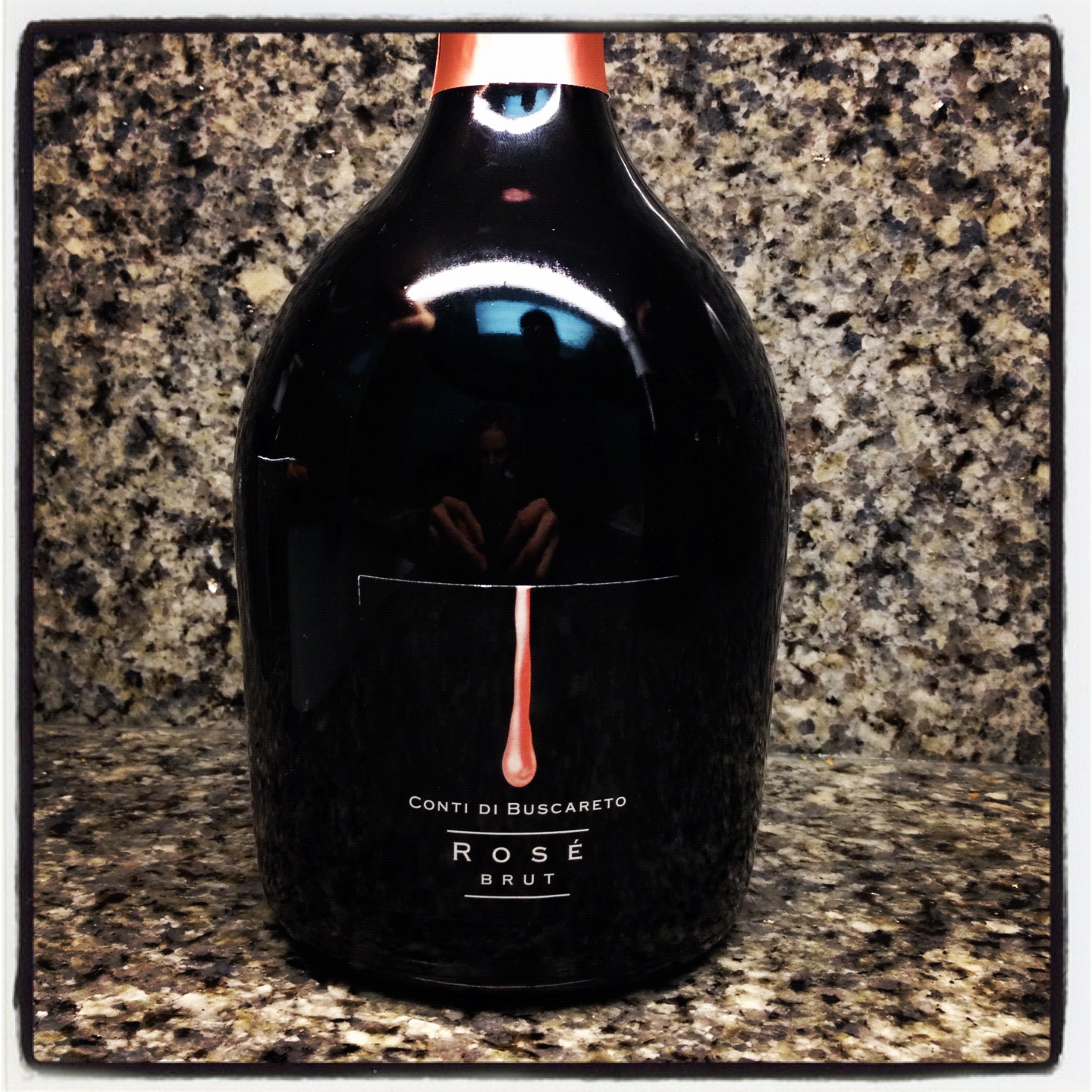A visit to the French region of Champagne, visiting houses and growers, caves and restaurants, offers a little glimpse into the places that make these very specific wines. With their somber countenance and chic looks, the Champenois embody the seriousness with which Champagne is produced and marketed. No region in world is known so much for such internationally acclaimed brands, whose producers seek to create the same quality and style of wine year in and year out. They painstakingly blend grapes and vintages for the perfect base wine, and then they wait. The patience that is required to make these wines, letting some age for up to ten years, is the ultimate expression of refinement. Continue reading
Category Archives: Wine
Domaine Julien Meyer Pinot Gris 2009
 Change in season. The older I get, the harder it is for me to cope with the turn of cool to warm, hot to cold again, overcome by barometric languor. One thing that helps me to cope is the delicious variety of fall whites that I suddenly start to crave. The nutty, slightly oxidized flavors of this rich, strange Alsatian pinot gris were the perfect fall into, well, fall.
Change in season. The older I get, the harder it is for me to cope with the turn of cool to warm, hot to cold again, overcome by barometric languor. One thing that helps me to cope is the delicious variety of fall whites that I suddenly start to crave. The nutty, slightly oxidized flavors of this rich, strange Alsatian pinot gris were the perfect fall into, well, fall.
Patrick Meyer, the son of the founder, has embraced biodynamic practices, and a quirky nature shows through in this wine. It’s not a typical Alsatian pinot gris: the honeyed, medium-rich nectar rests delicately on the palate, its richness sitting warmly in the mouth, yet brightened by the minerality and acidic backbone typical of the region’s wines. The perfect wine to carry me into autumn.
4 out of 5 stars.
Imported by Costello Wines.
1981 Chateau La Tour Figeac
 This wine from St. Emilion on Bordeaux’s right bank is predominantly of merlot and cabernet franc. It’s a Grand Cru Classé, a second tier wine from St. Emilion’s 1954 classification. The area is full of hillsides with limestone outcroppings and plateaus, along with gravelly terraces: the soil a hodge-podge of clay, sand, quartz, and chalk.
This wine from St. Emilion on Bordeaux’s right bank is predominantly of merlot and cabernet franc. It’s a Grand Cru Classé, a second tier wine from St. Emilion’s 1954 classification. The area is full of hillsides with limestone outcroppings and plateaus, along with gravelly terraces: the soil a hodge-podge of clay, sand, quartz, and chalk.
I decanted the wine two hours before we planned to drink it. The cork crumbled as we tried to pull it out, so we pushed it in and poured the wine through a coffee filter into a cut-crystal vase. The wine was a garnet, rusty color, with a nose of stewed fruit, earth, and fruit leather.
Two hours later, the nose had burst open into notes of dark berries and prunes. On the palate, it was brighter, ripe with fresh berry notes and a tangy finish.
Beautiful paired with blue cheese, such as a quiche au Roquefort.
4 out of 5 stars.
Red, Pink, & Bubbly
There’s something inherently special about a glass of sparkling wine, and all the more so if it’s toasting a romantic evening. But the magic isn’t just in the sipping: these wines almost always have an interesting story to tell about their creation, too, especially when the grapes in question aren’t white. I’ve always been especially curious about the treatment of the red grapes of Champagne—pinot noir and pinot meunier—whether quickly pressed and made into white wine or left on the skins, their pink juices mixed in later on. Although many common sparkling wines are white, I’ve been seeing more and more bottles that use red grapes, from the more traditional red pinots to indigenous varieties like grolleau. Here are some of the more interesting (and delicious!) sparkling reds and rosés I’ve come across recently, just in time for the iconic colors of Valentine’s Day. Continue reading
Banfi Rosa Regale Brachetto d’Acqui 2007 & 2010
I’ve been holding onto a little 2007 350 ml since February 2009, never quite sure of when to pop it. In fact, I’d held onto it for so long that I’d begun to wonder if it would be any good.
Produced in the town of Acqui in the Piedmont region of Italy (DOCG), Brachetto d’Acqui is a slightly sweet sparkling red made from the Brachetto grape. It has a soft effervescence, produced by the Charmat method, where the secondary fermentation occurs in tanks just before bottling. Typically, this method is used for wines that are meant to be consumed young, hence my nervousness about having held onto it. Continue reading
Lucien Albrecht Crémant d’Alsace Brut Rosé NV
 I first tasted this beautifully refreshing bubbly as an aperitif at Atlanta’s Miller Union restaurant and quickly fell in love. Continue reading
I first tasted this beautifully refreshing bubbly as an aperitif at Atlanta’s Miller Union restaurant and quickly fell in love. Continue reading
Conti di Buscareto Rosa NV
 A beautiful, rich, salmon-colored wine, the Conti di Buscareto Rosé is made from the Lacrima di Morro d’Alba grape in Italy’s Marche region, an ancient varietal rarely seen from outside of this region. Its name comes from its shape, which is reminiscent of a tear. Continue reading
A beautiful, rich, salmon-colored wine, the Conti di Buscareto Rosé is made from the Lacrima di Morro d’Alba grape in Italy’s Marche region, an ancient varietal rarely seen from outside of this region. Its name comes from its shape, which is reminiscent of a tear. Continue reading
Kim Crawford Pinot Noir 2009
I first heard about Kim Crawford a few years ago while I was working at Alphabet City Wine Co. in New York when a few women came in looking for the sauvignon blanc. We didn’t carry it, but I made a mental note to find and try it. Well now I see ads for it everywhere, and it’s no wonder; the wine is imported by the behemoth wine company Constellation Wines from Marlborough, New Zealand. I found it, tasted and enjoyed it, and moved on.
Pascal Pibaleau “La Perlette” Sparkling Grolleau NV
 Don’t be fooled like I was – that dark-colored bottle is clear, showing the rich, raspberry color of the wine itself. 100% Grolleau, an almost extinct deep red grape from the Loire, this red wine is classically vinified as a rosé; winemaker Pascal Pibaleau has crafted a lovely sparkling red in the frizzante (slightly fizzy) style. Continue reading
Don’t be fooled like I was – that dark-colored bottle is clear, showing the rich, raspberry color of the wine itself. 100% Grolleau, an almost extinct deep red grape from the Loire, this red wine is classically vinified as a rosé; winemaker Pascal Pibaleau has crafted a lovely sparkling red in the frizzante (slightly fizzy) style. Continue reading
A Different Kind of Vet: Franciscan Winery’s Chef
 I spent Veterans’ Day at Franciscan Winery in Napa Valley in the company of winemaker Janet Myers and chef Cory Strike. Both have been at the winery for several years, 8 and 10 years respectively, but Strike turned out to be a more traditional kind of vet as well: he took leave in 2004 and volunteered to spend four years in Iraq, running the kitchen for the US Army, serving over 22,000 meals each day. We tasted a little more refined version of his cooking over lunch, alongside three beautiful wines—the 2009 Franciscan Cuvée Sauvage reserve Chardonnay, the 2006 Franciscan Magnificat Cabernet Sauvignon, and the 2004 Mount Veeder Reserve Meritage blend. An excellent way to toast him and all those who have served.
I spent Veterans’ Day at Franciscan Winery in Napa Valley in the company of winemaker Janet Myers and chef Cory Strike. Both have been at the winery for several years, 8 and 10 years respectively, but Strike turned out to be a more traditional kind of vet as well: he took leave in 2004 and volunteered to spend four years in Iraq, running the kitchen for the US Army, serving over 22,000 meals each day. We tasted a little more refined version of his cooking over lunch, alongside three beautiful wines—the 2009 Franciscan Cuvée Sauvage reserve Chardonnay, the 2006 Franciscan Magnificat Cabernet Sauvignon, and the 2004 Mount Veeder Reserve Meritage blend. An excellent way to toast him and all those who have served.
